The Xiaomi NoteBook Pro 120G is the company’s premium productivity laptop. It features an all aluminum body, a 120Hz high resolution display, the latest 12th generation Intel i5 processor and Thunderbolt connectivity. The 120G model we’re testing today also includes dedicated Nvidia graphics.
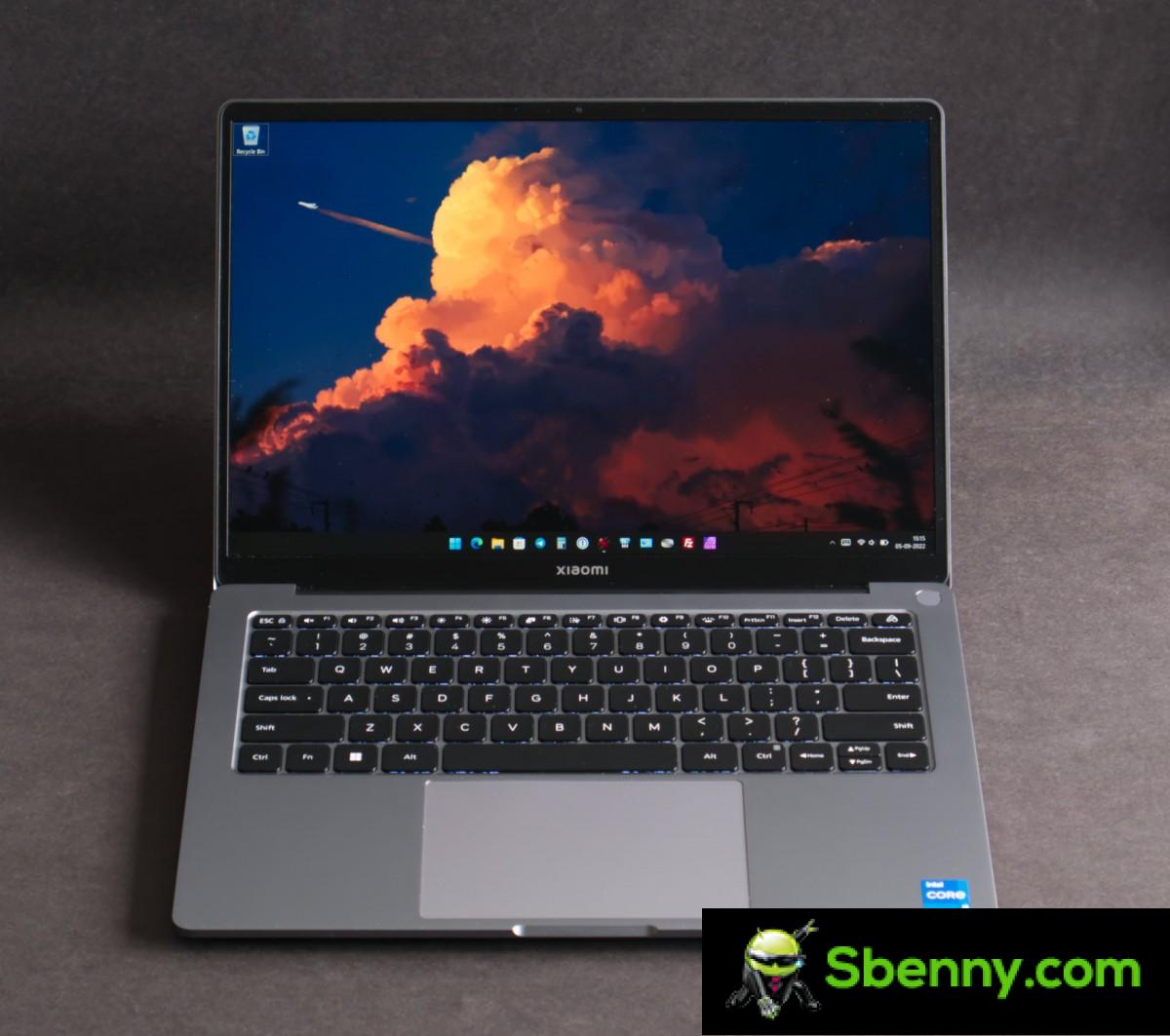
Launched earlier this month in India, the NoteBook Pro 120G is the most premium Xiaomi notebook on the market. With the company rapidly gaining ground as a renowned computer manufacturer, this is a good time to start launching more premium products, and the 120G is exactly that. It positions itself right in the middle of the thin and light productivity laptops and the thicker, heavier gaming laptops that populate this segment as they try to offer a little of both. Let’s see how it behaves.
Drawing
The Xiaomi NoteBook Pro 120G has an attractive and minimal design which is heavily influenced by the fourth generation MacBook Pro models. It uses an aluminum frame for the lid, keyboard and back panel and is available in a single dark gray color.

The Xiaomi NoteBook Pro 120G is incredibly well built and finely crafted hardware. Everything from the firmly damped movement of the hinge to the texture of the anodized aluminum feels extremely premium. The keyboard is sturdy and shows no flexibility. The whole machine looks like a solid sheet of metal.
The lid takes some effort to lift, but it moves easily afterwards and stays in place wherever you leave it. The display opens quite wide although not quite 180 degrees like other laptops. The exhaust vents for the cooling system are located next to the hinge.

Inside, the matte display has a matte black plastic frame surrounding it. The bezel is relatively thin and the matte texture shows no smudges or fingerprints. However, you will regularly cover the webcam with your thumb as you open the lid as it is right on the edge and has no cover. If you are going to use it, you should clean it beforehand.
The back of the notebook has an aluminum cover with a grille in the center for the cooling outlet and two grilles below for the down-firing speakers. The lid is held in place by eight screws but requires a plastic spudger to open without scratching the metal.
On the flip side, you may have noticed that Xiaomi now puts its logo on the lid, as the company’s first notebooks were shipped without logos. The Xiaomi branding is thin and uses the company’s new font.

As with other logos, there is a single Intel sticker on the keyboard in the lower right corner. The rest of the stickers, including one for Nvidia and Microsoft Office, are placed on the bottom where they are usually hidden.
The laptop weighs 1.4 kg, which is the norm for this size class. It is not very light but it is perfectly manageable and light enough to be carried around all day.
Screen
Xiaomi NoteBook Pro 120G has a 14-inch matte IPS LCD, 2560×1600 resolution with refresh rate up to 120Hz. Xiaomi claims 100% coverage of the sRGB and dE color space

The display has outstanding color performance, with accurate gamma tracking and a measured average dE2000 of 1.01, with a single color exceeding the humanly perceptible imprecision threshold of dE
Peak brightness was measured at anemic 255 nits with an average contrast ratio of just over 1100: 1. There is no local dimming and the display has standard side lighting. The viewing angles are good and the matte finish disperses many reflections at the expense of contrast and color rendering. Outdoor visibility under strong lighting is poor.



View report
Overall color performance is very good, making the display ideal for everyday content consumption and some light color sensitive jobs. For more serious color work, you will need to perform hardware calibration. However, the lack of adequate color coverage and a relatively poor 10-bit peak contrast and brightness ratio means that an external monitor is best considered for color-sensitive work.

The laptop does not support PQ HDR, so HDR cannot be enabled in Windows and supported apps and games. However, Windows includes an additional HDR streaming option, which can enable support for HDR content in compatible apps. Netflix, for example, will serve HDR content when this option is enabled. However, the panel isn’t equipped to display HDR content, so it often ends up looking worse than SDR.

The display has below average motion performance. The peak refresh rate of 120Hz offers significantly improved smoothness of motion, and applications that support it feel much more responsive. However, the display has poor response times which is quite typical of non-gaming IPS laptop displays due to the lack of pixel overdrive. This results in long motion tracks behind fast moving objects as the pixels are too slow to pass within the 8.33ms refresh window.
The Xiaomi NoteBook Pro 120G is only available in one size. The 14-inch panel has a good pixel density thanks to the relatively high resolution. However, it looks cramped at the default 200% scaling, and anything below it is too small and hard on the eye. Windows application scaling is everywhere too, but that’s a discussion for another day.
Keyboard and trackpad
The Xiaomi NoteBook Pro 120G has a standard chiclet-style membrane keyboard. The keys use a scissor mechanism and have a travel of approximately 1.3 mm.
The keyboard has a white LED backlight that can be set to low, high or automatic brightness. By default, the backlight is set to turn off after 15 seconds of not using the keyboard. This can be very annoying and the option to keep it permanently enabled is found in the BIOS, which you need to access by holding down F2 during boot.
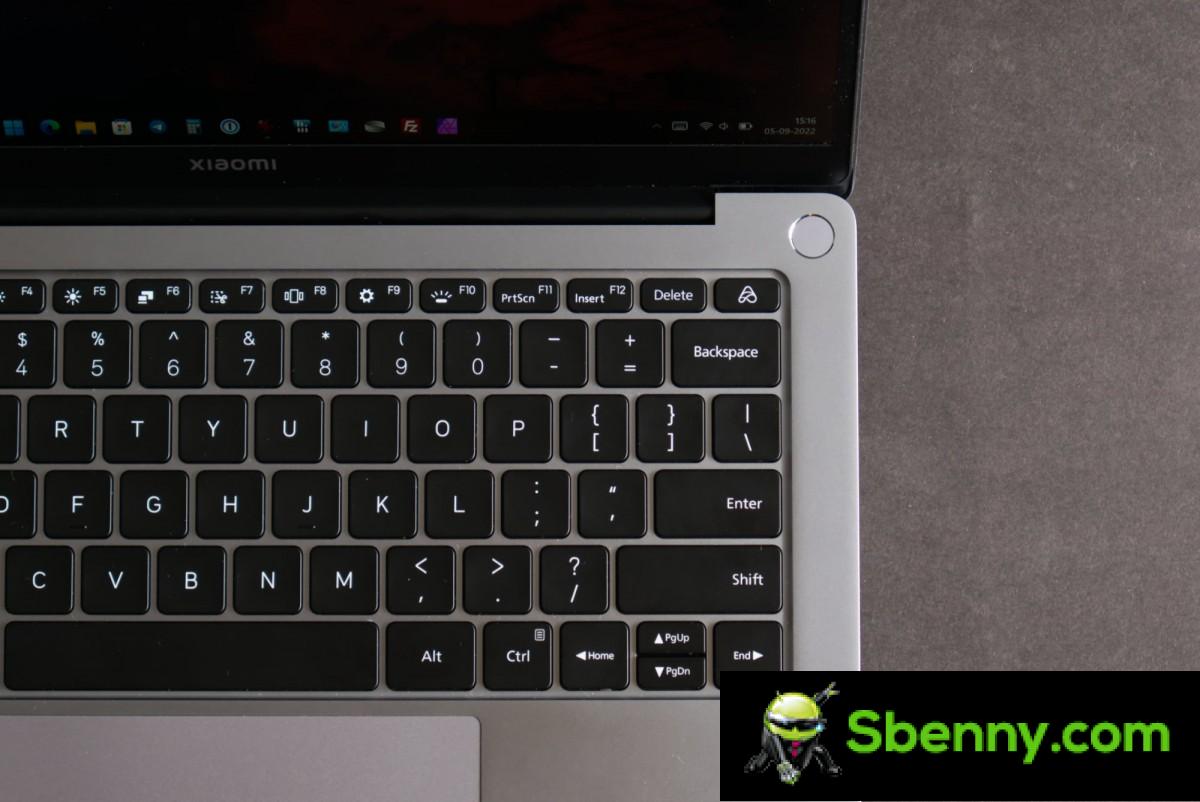
The keyboard has a row of Fn keys at the top, which are also assigned alternative shortcuts. You can access the Fn commands by first pressing the Fn key. Alternatively, you can press Fn + Esc and switch to using the Fn commands by default and access shortcuts by pressing the Fn keys first.
The keyboard also has a dedicated macro key in the upper right corner. You can set any application or file to open when this key is pressed. Only one thing can be assigned to the key at a time. The macro key requires a heavier actuation force, which can prevent accidental presses.
The keyboard of the Xiaomi NoteBook Pro 120G is excellent. The keys are well spaced and have very satisfying damping to the spring mechanism which makes it a pleasure to type. The sound of the keys is also well damped and is neither too loud nor too mushy.
The key backlight is bright enough at maximum and the bleeding around the edges isn’t bad. The key legends are always visible both in the light and illuminated by the backlight. The key material is smooth to the touch and does not grease easily.
In the upper right corner of the keyboard is the power button with an integrated capacitive fingerprint sensor. This sensor is quite slow and takes a second and a half to read your fingerprints.

Below the keyboard is the large plastic trackpad. The trackpad is hinged at the top and the bottom physically moves to record clicks. This means that you can press about 60% of the bottom of the trackpad to record a click while the top 40% can’t move much because it’s close to the hinge.
The trackpad is mostly good. The surface has an excellent structure that makes smooth and precise movements possible. The clicks give them a sturdy feel. The only problem I encountered was double clicking with the capacitive touch surface. When tapping the surface, the trackpad can sometimes record two clicks, which can cause all kinds of problems like invariant dragging of a window when you just want to move the pointer or open files you just want to drag.
The problem seems to be due to the sensitivity of the touch surface, which seems a bit high at the moment. The trackpad also doesn’t work properly if your palm is resting on the edge, which can happen quite often due to its large size. Two-finger gestures turn into three-finger gestures if you don’t notice that your palm is resting on the edge of the trackpad, which can be annoying or dangerous if, like me, you’ve set three-finger scrolling to adjust the volume. Such a large trackpad simply cannot afford not to have any palm rejection. Hopefully this will be fixed in a driver update.
Speakers, microphone, webcam
The Xiaomi NoteBook Pro 120G has two down-firing speakers on both sides. The speakers without any improvement deliver laptop-typical quality audio, which means they’re horrible. However, the pre-installed DTS Audio Processing app is capable of doing amazing magic on it, which results in a really decent audio experience. I just don’t recommend using the speakers without this app.
The app remains active even if you connect wired headphones. Audio processing, which is meant for speakers, is overbearing for headphones, so I recommend turning it off. Unfortunately, there is no way to set the app to automatically disable itself when using headphones. A workaround is to use wireless headphones, which are not supported by the app.

The quality of the microphone is somewhat poor. Voice recordings sound muffled and compressed, even when saved in a lossless codec.
The 720p webcam has poor image quality and also does not support Windows Hello. It also doesn’t have any privacy coverage, so you have to resort to your own measures to cover it. I would recommend covering it up permanently and buying an aftermarket webcam with a good replacement microphone if you have a lot of video calling.
Connectivity
Xiaomi NoteBook Pro 120G is equipped with a single USB 3.1 Gen 1 Type A port, a USB 3.2 Gen 2 Type C port and a Thunderbolt 4 port. There is also an HDMI 2.0b connector and a headphone / microphone jack. 3.5 mm.

The connectivity options are quite limited. The single Type-A port usually gets busy very quickly and at least one of the USB-C ports is required for charging, often leaving you with only one spare USB-C port for the rest of your devices. Plus, there’s no SD reader or wired Ethernet media, so you’re looking to live the dongle life enough if you have a lot of wired devices you need to plug in.

The good thing about the port design is that there is a USB-C port on both sides, which means you can charge the laptop from whichever side is most comfortable for you. The right USB-C port has a charging light next to it, but it also lights up if you use the port on the left side.

As for wireless, Xiaomi NoteBook Pro 120G supports dual-band Wi-Fi 6 and Bluetooth 5.2. Both performed well during testing with no connectivity issues.
Software
Xiaomi NoteBook Pro 120G comes with Windows 11 Home. In terms of pre-installed software, Xiaomi notebooks have always taken a very conservative approach, with no bloatware from the company. Most of the bloatware actually comes only from Microsoft, which is becoming more and more shameless about what it can pre-install on a paid operating system.

The apps pre-installed by Xiaomi are Mi Support, MIUI + (previously MiDrop) and Macro. The Mi Support app shows the basic specifications of the machine, has a link to the company’s support page and allows you to change some display settings. The MIUI + app allows you to transfer files from another device running the app. The Macro app allows you to configure the preset function for the macro key on the keyboard.

Aside from that, there’s really nothing else included. I would have appreciated a utility to adjust fan speeds or performance profiles, but Xiaomi has grouped this into one mode. You can press Fn + K to toggle between the default balance mode and a quiet mode with a slower maximum fan speed and lower performance.
However, the lightweight software experience is definitely a breath of fresh air as the computer is pretty much in the prime state right out of the box and you don’t have to waste time uninstalling a bunch of bloatware that almost every other company cram into their computer.
Performance
The Xiaomi NoteBook Pro 120 is available in two variants. Both are equipped with Intel Core i5-12450H, which has 8 physical cores (4x P-core, 4x E-core) and 12 threads. It can boost up to 4.4GHz on P-cores and has a 12MB cache. It has a base TDP of 45W but can boost up to 95W during the turbo window, although Xiaomi has configured its PL2 and PL1 to 85W and 40W respectively.
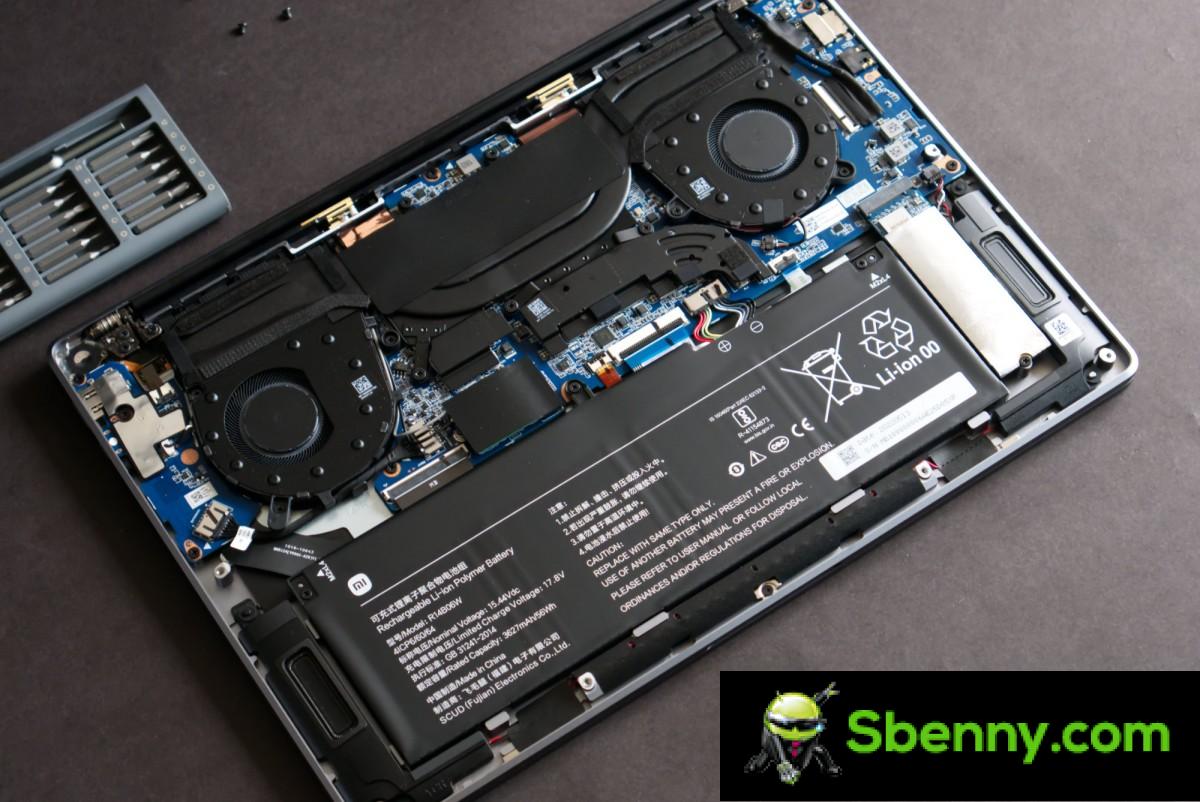
Both models also include 16GB of onboard 5200MHz LPDDR5 memory and 512GB of PCIe 4.0×4 NVMe M.2 flash memory. Memory is fixed but you can replace the pre-installed Phison M.2 with a drive of your choice if you need more space or speed.
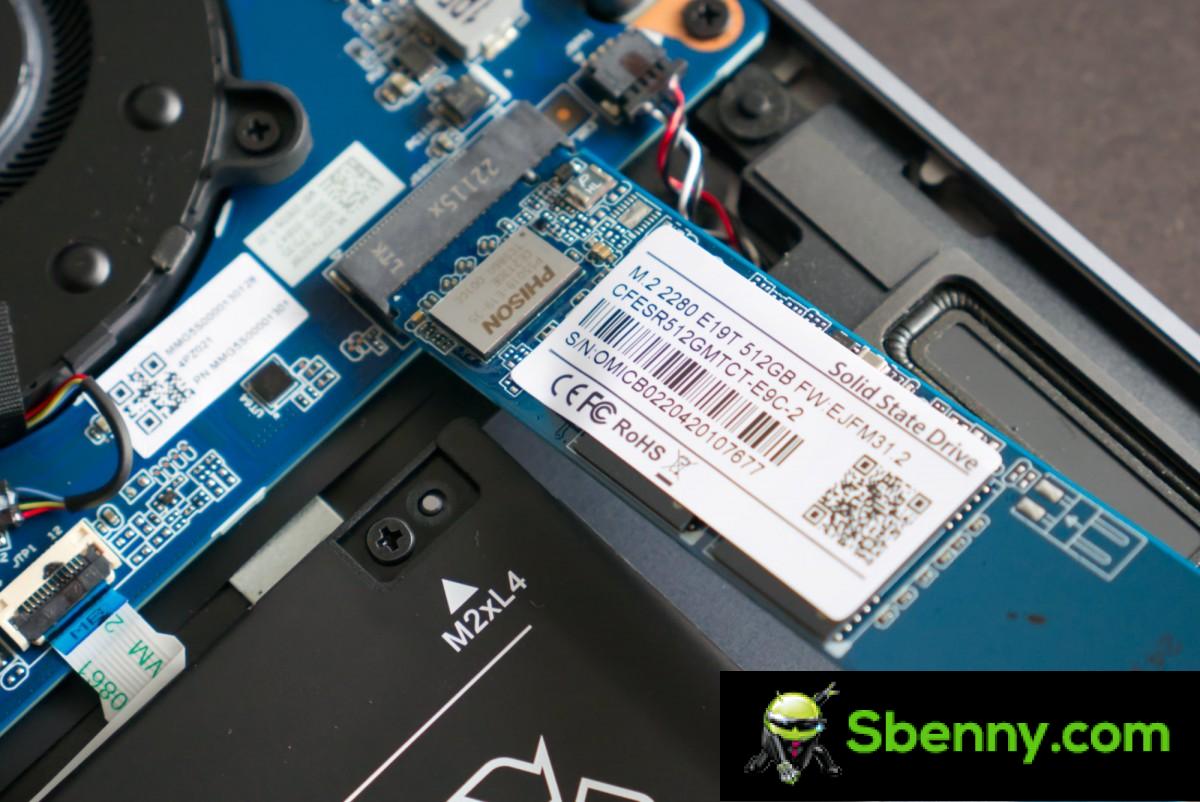
The only difference between the NoteBook Pro 120 and the 120G is the presence of dedicated Nvidia GeForce MX550 graphics with 2GB of GDDR6 video memory on the 120G. The MX550 works in conjunction with the integrated Intel Iris Xe graphics built into the CPU.
Starting with some productivity tests, the Xiaomi NoteBook Pro 120G performs well, performing well in everyday tasks such as web browsing, office applications, and light image and video editing. Unfortunately, the limited memory and storage options prevent you from using the laptop as a full-time workstation as one or both of your memories will run out sooner rather than later.

Game performance is similarly hampered by cost-cutting measures. The MX550 is a distinct step back from Nvidia’s RTX series options, but can still hold its own in older games or modern competitive titles. Unfortunately, more often than not, you’ll run out of VRAM before hitting the GPU limits, which can be quite disappointing.
Many of the modern AAA titles just assume that you will have at least 4GB of memory for your graphics. Some will gracefully fit for the 2GB, some will show scary warning signs when starting the game, some will have severe performance issues even if you turn down texture settings completely, and others won’t load at all or just crash.

Among the games tested here, it was mainly the competitive titles that ran smoothly. Older games like GTA V also performed quite well and you could even set some settings to improve the viewing experience. Be careful with increasing the resolution, however, as it has a much greater impact on video memory than anything else.
Other games have had much more serious problems. Red Dead Redemption 2 wouldn’t even allow you to set resolutions higher than 768p (and for some reason it won’t even go full screen). Death Stranding would work after showing warnings that the hardware is not powerful enough and therefore would simply crumble during gameplay. Resident Evil Village had such performance issues in the village square area that the game speed actually slowed down with the frame rate, making it look like it was running in slow motion. God of War seems to work fine, but then it will have big stutters and slowdowns every time it has to load a new area in memory.
Of course, memory is not always the bottleneck. The MX550 can’t do 1080p 60fps in most modern titles even at the lowest settings, and even 30fps is sometimes hard to maintain. You can go down further to 900p or 720p but the image quality deteriorates noticeably. Additionally, there’s no support for DLSS, and unless the game supports FSR 2.0, there’s not much hope of improving image quality at lower resolutions.
Things are much better when playing competitive multiplayer titles. Unfortunately, you’ll have to contend with screen tearing as there’s no G-Sync support, even though the panel itself has a variable refresh rate range of 48-120Hz. The display’s slow response times also make images blurry.
While the dedicated GPU isn’t much use for gaming, it can still be used in productivity applications designed to take advantage of Nvidia’s CUDA platform. Applications like Blender can cut render times in half when using CUDA for rendering. However, anything that requires a lot of video memory, like photo or video editing applications, will run into the same 2GB memory bottleneck as games. Alternatively, the integrated Iris Xe GPU is quite capable of performing basic image and video decoding tasks.

The default Phison E19T SSD is pretty average. Despite PCIe Gen 4×4 support, speeds are more in line with PCIe Gen 3 SSDs. They are still faster than 3.5-inch SATA SSDs but much slower than you’d expect from a Gen 4 drive.
The cooling solution is adequate for everyday use but is not optimal for heavy workloads or those requiring long-term CPUs. In an all-core workload, temperatures can quickly reach 100 ° C during the PL2 window, with a power draw of approximately 65 W. Clock speeds are approximately 4.1 GHz and 3.3 GHz, respectively. on the P and E-core cores. After the tau expiration, the CPU settles at 40 W PL1 with clock speeds of approximately 3.1 GHz and 2.7 GHz respectively. Temperatures remain in the 80’s.
In gaming workloads, P-cores can briefly hit the advertised boost clocks of 4.4 GHz, and CPU temperatures remain mostly below 80 C if gaming is GPU-bound (which is usually it is the case). The GPU itself rarely exceeds 70 ° C as it only draws around 30W under maximum load. All tests were performed in a 22 ° C environment.

The fans of the Xiaomi NoteBook Pro 120G are not particularly quiet. They often remain audible while working in a warm room and rarely go completely silent. At higher speeds, the wind sound is a little loud but still mostly harmless. The problem is with the fan motors and the high-pitched whistle they produce, which can be quite noticeable at higher speeds and gets a little annoying.
Quiet mode limits the fan speed where they are still audible but never get loud. When attempting to run a heavy all-core CPU workload in this mode, the packet power does not go beyond 45W and clock speeds are limited to 3.4GHz on the P-cores and 2.8GHz on E-cores. Shortly after starting the test, the system discovers that it cannot maintain this power limit at low fan speeds and thus the CPU package power plummets to just 15 W and the core clock at 1.2 GHz on all eight. core. This is also what the system will drop to if it initiates thermal throttling in balanced mode.
Running the laptop on battery power comes with a hefty performance penalty. The power limit is set at just 15W and the maximum clock speed is 1.2GHz on all cores. This reduces the performance in Cinebench by almost 62% and the machine sometimes feels noticeably slow. Unfortunately, there is no way to change the performance characteristics as the Silent and Balanced profiles are exactly the same when running on battery.
Battery
The Xiaomi NoteBook Pro 120G has a 56 Wh battery. Xiaomi claims 9 hours of battery life for regular productivity use.
I’m not sure how the company managed to achieve that, but I only managed to get around 4-5 hours of use on a full charge, again with the display set to a conservative brightness of 100 nits. I also set it to 120Hz and I suspect Xiaomi’s claim is based on the 60Hz setting, which is the default.
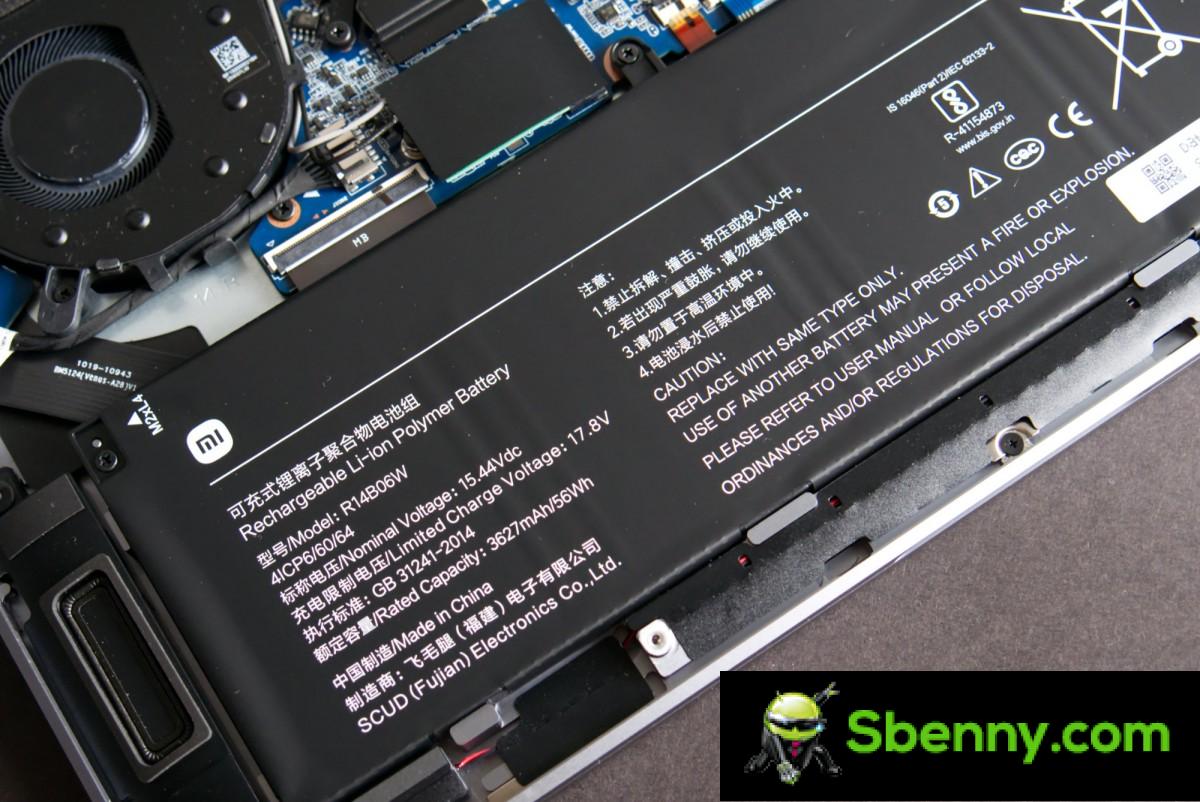
If you feel you don’t need the full 120Hz refresh rate at all times, you can quickly switch between 60Hz, 90Hz and 120Hz using the Fn + S shortcut. 60Hz should help you get a few extra hours out of the battery if you stay away from the charger for some time.
Xiaomi NoteBook Pro 120G comes with a 100W USB-C charger. Xiaomi claims that the laptop can charge from 0 to 50% in 35 minutes. You can also use any USB-PD charger with the notebook, including some power banks.
Conclusion
The Xiaomi NoteBook Pro 120G is priced at INR 74,999 ($ 1000) while the non-G model is priced at INR 69,999 ($ 879).

The 120G is a well designed and well built laptop with a superb fit and finish. The display has good color accuracy out of the box. The keyboard and trackpad are good, as is performance for school, office, and basic productivity tasks. You can also get away with some gameplay, as long as you like light competitive multiplayer or old AAA titles.
The laptop is held back by its poor memory options, both for the system and for the graphics. This limits its use as an editing PC and prevents memory-intensive apps and games from running. Display brightness is also very conservative and response times are poor for a good high refresh rate experience. Battery life is also below average.
Despite these problems, the Xiaomi NoteBook Pro 120G is a good all-round option for those looking for an attractive and well-built laptop for everyday use. Personally, I’d go for the cheaper 120 model, as the dedicated graphics on the 120G don’t bring much to the table. If you need dedicated graphics, whether for gaming or high productivity applications, better options are available.







Start a new Thread